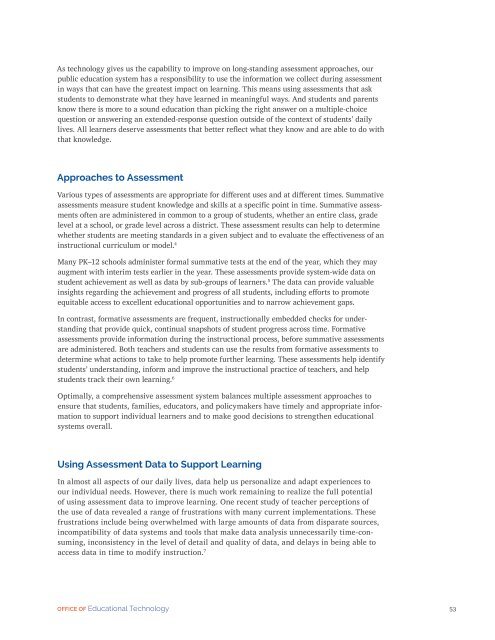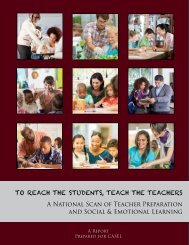Future Ready Learning
7m3sdJ
7m3sdJ
You also want an ePaper? Increase the reach of your titles
YUMPU automatically turns print PDFs into web optimized ePapers that Google loves.
As technology gives us the capability to improve on long-standing assessment approaches, our<br />
public education system has a responsibility to use the information we collect during assessment<br />
in ways that can have the greatest impact on learning. This means using assessments that ask<br />
students to demonstrate what they have learned in meaningful ways. And students and parents<br />
know there is more to a sound education than picking the right answer on a multiple-choice<br />
question or answering an extended-response question outside of the context of students’ daily<br />
lives. All learners deserve assessments that better reflect what they know and are able to do with<br />
that knowledge.<br />
Approaches to Assessment<br />
Various types of assessments are appropriate for different uses and at different times. Summative<br />
assessments measure student knowledge and skills at a specific point in time. Summative assessments<br />
often are administered in common to a group of students, whether an entire class, grade<br />
level at a school, or grade level across a district. These assessment results can help to determine<br />
whether students are meeting standards in a given subject and to evaluate the effectiveness of an<br />
instructional curriculum or model. 4<br />
Many PK–12 schools administer formal summative tests at the end of the year, which they may<br />
augment with interim tests earlier in the year. These assessments provide system-wide data on<br />
student achievement as well as data by sub-groups of learners. 5 The data can provide valuable<br />
insights regarding the achievement and progress of all students, including efforts to promote<br />
equitable access to excellent educational opportunities and to narrow achievement gaps.<br />
In contrast, formative assessments are frequent, instructionally embedded checks for understanding<br />
that provide quick, continual snapshots of student progress across time. Formative<br />
assessments provide information during the instructional process, before summative assessments<br />
are administered. Both teachers and students can use the results from formative assessments to<br />
determine what actions to take to help promote further learning. These assessments help identify<br />
students’ understanding, inform and improve the instructional practice of teachers, and help<br />
students track their own learning. 6<br />
Optimally, a comprehensive assessment system balances multiple assessment approaches to<br />
ensure that students, families, educators, and policymakers have timely and appropriate information<br />
to support individual learners and to make good decisions to strengthen educational<br />
systems overall.<br />
Using Assessment Data to Support <strong>Learning</strong><br />
In almost all aspects of our daily lives, data help us personalize and adapt experiences to<br />
our individual needs. However, there is much work remaining to realize the full potential<br />
of using assessment data to improve learning. One recent study of teacher perceptions of<br />
the use of data revealed a range of frustrations with many current implementations. These<br />
frustrations include being overwhelmed with large amounts of data from disparate sources,<br />
incompatibility of data systems and tools that make data analysis unnecessarily time-consuming,<br />
inconsistency in the level of detail and quality of data, and delays in being able to<br />
access data in time to modify instruction. 7<br />
OFFICE OF Educational Technology<br />
53



